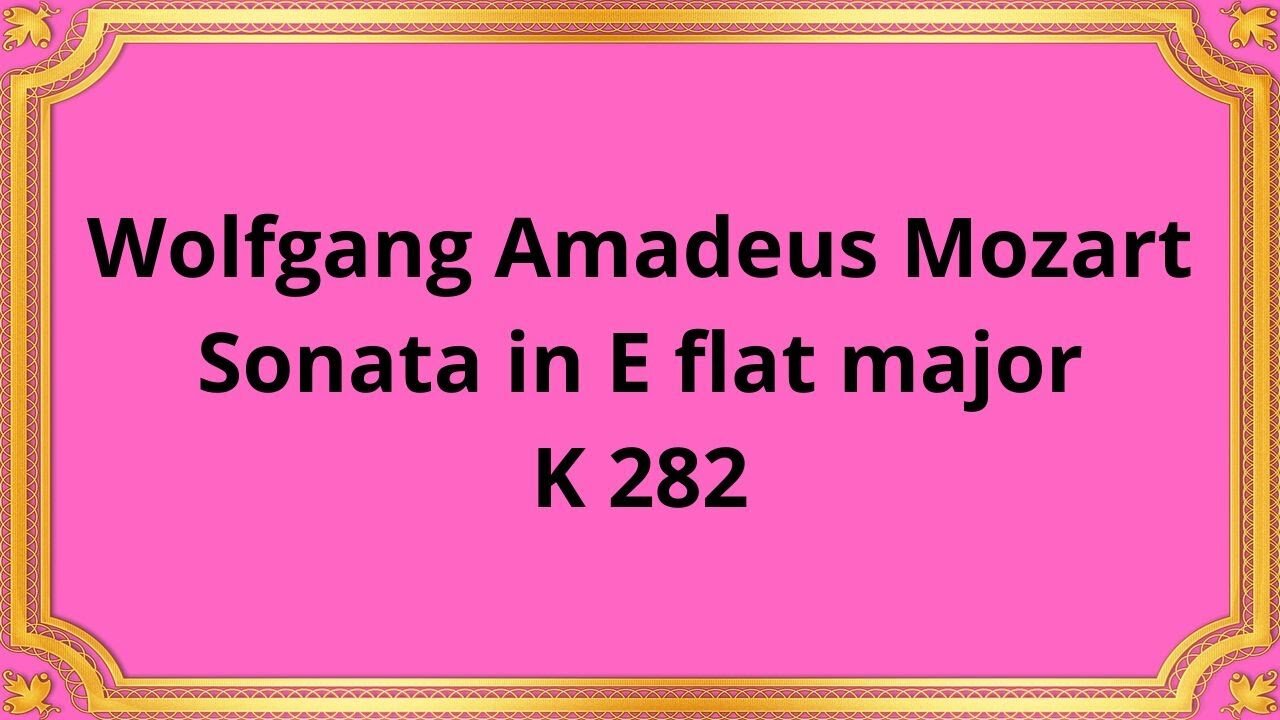Premium Only Content

Wolfgang Amadeus Mozart Sonata in E flat major K 282
#Mozart #Sonata #ClassicalMusic #MusicalComposition #Eflatmajor #K282 #Piano #Composer #BaroqueMusic #MusicHistory
Publication date 1938
Kathleen Long (piano)
Wolfgang Amadeus Mozart, a prodigious composer of the Classical era, left an indelible mark on the world of music. Among his vast repertoire, the Sonata in E flat Major K. 282 stands out as a masterpiece of elegance and brilliance.
The Sonata genre has been a cornerstone of classical music, showcasing the virtuosity and expressive capabilities of the piano. Mozart's Sonata in E flat Major K. 282 is a prime example of this genre, highlighting his impeccable craftsmanship and ability to create captivating compositions.
Mozart composed the Sonata in E flat Major K. 282 in 1774 when he was just 18 years old. This sonata consists of three movements, adhering to the classical sonata structure:
1. Adagio: The opening movement sets a contemplative and introspective tone. It unfolds with delicate grace, presenting a lyrical and expressive melody that showcases Mozart's gift for crafting beautiful and emotive musical phrases.
2. Menuetto I and II: The second movement is a minuet and trio, a traditional dance form of the time. Mozart weaves a charming and elegant melody, alternating between the graceful minuet and the contrasting trio section, providing a delightful contrast in mood and character.
3. Allegro: The final movement is a lively and spirited composition, characterized by its joyful and exuberant nature. It displays Mozart's technical prowess and command of the piano, featuring rapid passages, dynamic contrasts, and intricate fingerwork.
Mozart's Sonata in E flat Major K. 282 is distinguished by its captivating melodies. The composer's ability to craft memorable and expressive themes is evident throughout the sonata, immersing the listener in a world of melodic enchantment.
Mozart's harmonic choices in K. 282 display a level of sophistication and innovation. The harmonic progressions and unexpected modulations add depth and complexity to the composition, elevating it beyond mere technical brilliance.
The sonata showcases Mozart's mastery of expressive dynamics. From delicate and tender moments to bold and powerful passages, the range of dynamics creates a compelling musical narrative that evokes a wide range of emotions.
Mozart's Sonata in E flat Major K. 282 demonstrates his impeccable sense of structure and form. The seamless transitions between movements, balanced thematic development, and overall coherence contribute to the sonata's timeless appeal.
Mozart's Sonata in E flat Major K. 282 holds significant importance within the realm of classical music. Despite being composed at a young age, the sonata exemplifies Mozart's maturity as a composer, showcasing his innate musical genius and ability to create captivating compositions. It has been admired for centuries, both for its technical brilliance and its ability to evoke a profound emotional response from the listener.
Conclusion:
Wolfgang Amadeus Mozart's Sonata in E flat Major K. 282 is a testament to the composer's remarkable talent and his impact on the world of classical music. With its melodic beauty, harmonic sophistication, expressive dynamics, and structural integrity, the sonata continues to captivate audiences and stands as a testament to Mozart's enduring legacy. It remains a shining example of his brilliance as a composer, leaving a lasting impression on both performers and listeners alike.
You have the opportunity to support the channel:
https://destream.net/live/RadSiarAl/donate
https://www.buymeacoffee.com/6355radsiaral
-
 5:42:36
5:42:36
FreshandFit
1 day agoLive X Censorship For Opposing Immigration?!
244K117 -
 1:08:16
1:08:16
Tactical Advisor
20 hours agoNEW Budget Glocks | Vault Room Live Stream 011
127K9 -
 16:30
16:30
SNEAKO
1 day agoNO FRIENDS IN THE INDUSTRY.
162K72 -
 6:19
6:19
BlackDiamondGunsandGear
1 day agoHow Fat Guys can Appendix Carry
113K12 -
 6:58
6:58
Gun Owners Of America
1 day ago2024 Was Huge For Gun Rights, Here's Our Top 10 Wins!
91.1K8 -
 15:50
15:50
Degenerate Jay
1 day ago $3.37 earnedJames Bond Is Being Ruined By Amazon? Make Him A Black Gay Woman?
70K15 -
 15:18
15:18
DeVory Darkins
1 day ago $27.68 earnedTrump Drops NIGHTMARE Warning on Joe Biden
84.7K119 -
 36:13
36:13
The Why Files
1 month agoAlien Implants Vol. 1: Devil’s Den UFO Encounter: What Was Found Inside Terry Lovelace?
82.9K46 -
 9:03
9:03
Alabama Arsenal
2 days ago $1.35 earnedAAC HUB 2K | Modern Features, Iconic Classic Looks
29.9K1 -
 13:49
13:49
Dermatologist Dr. Dustin Portela
2 days ago $2.53 earnedDermatologist Reveals the Worst Things To Do To Your Skin
22.2K15